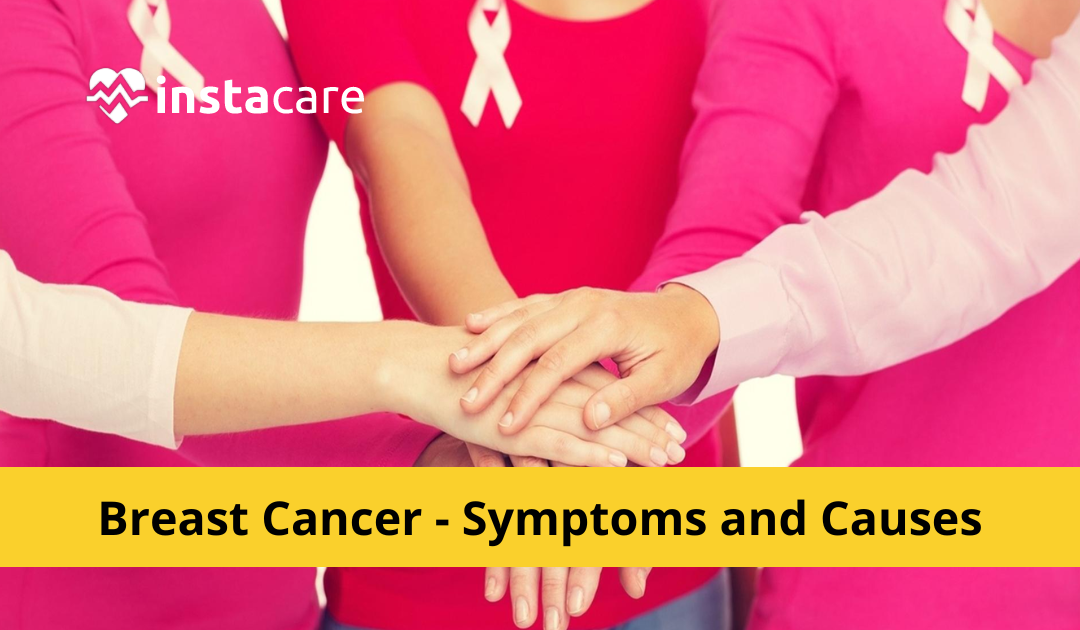Breast cancer is a cancerous tumour that develops in the breast cells. Breast cancer is also the second most frequent disease in American women after skin cancer. Men and women can also both develop breast cancer, although women are much more likely to do so.
Breast cancer diagnosis and treatment have advanced thanks to significant investment in research and awareness campaigns. Because of earlier identification, a new customized approach to therapy, and a better knowledge of the disease, the survival rates for breast cancer have grown, and the number of deaths linked to this disease is constantly falling. Symptoms and causes may also vary from person to person.
What Are The Early Signs?
A breast lump, an area with thicker tissue, or an area of thickened tissue in the armpit is frequently the earliest sign of breast cancer.
Other signs and symptoms include:
- breast or armpit soreness that is persistent throughout the menstrual cycle
- a rash around or on one nipple
- nipple discharge that can be bloody
- a sunken or inverted nipple
- an alteration in the breast's size or shape
The majority of breast lumps are also not malignant. Nevertheless, anyone who discovers a breast lump should have it examined by a medical expert.
Why Does Breast Cancer Occur?
When abnormal cells in your breast increase and grow, breast cancer develops. But the precise reason why this process starts in the first place is unknown to scientists. So, the pe of breast cancer treatment you get also depends on the factors involved. However, according to a study, several risk factors could raise your risk of having breast cancer.
View More: Myths About Breast Cancer
These consist of the following:
- Age: Having breast cancer increases your chances if you are 55 or older.
- Sex: Compared to men, women have a higher risk of developing breast cancer.
- Family History and Genetics: You have a higher chance of developing breast cancer at some time in your life if you have parents, siblings, children, or other close relatives diagnosed with the disease. Genetic testing reveals that 5% to 10% of breast cancers are caused by a single faulty gene handed down from parents to children.
- Smoking: Numerous cancers, including breast cancer, have been associated with tobacco use.
- Numerous more variables can raise your risk of acquiring breast cancer. Find out if you're in danger by speaking with your healthcare practitioner.
Breast Cancer Variations
The following are also some of the most typical kinds of breast cancer:
- Cancers In Situ: These varieties are still contained in the duct or lobule where they first appeared.
- Situs Ductal Carcinoma (DCIS) is early-stage ductal carcinoma (stage 0). The illness is still present in the milk ducts in this instance. However, it might spread if you don't treat this kind of cancer. It's usually treatable.
- In Situ Lobular Carcinoma (LCIS): Only the lobules that generate breast milk have this. Although it isn't genuine cancer, it increases your risk of developing breast cancer in the future. Get routine mammograms and breast exams if you have them.
- Widespread Cancers: These have spread or gotten within the tissue around the breast.
Exactly How Is Breast Cancer Addressed?
There are numerous breast cancer treatments available, including:
- surgery
- chemotherapy
- radiation treatment
- hormone treatment
- immunotherapy
- targeted medication therapy
The best course of the action for you will depend on several variables, including the size and location of the tumour, the findings of your lab tests, and if cancer has expanded to other areas of your body. Your healthcare practitioner will customize your treatment strategy according to your specific needs. Receiving a mix of different treatments is also not unusual.
View More: Breast Cancer Risk Factors
Predicting of Breast Cancer
Your doctor will start diagnosing breast cancer if you feel a lump or something is detected on a mammogram. The symptoms and causes will primarily affect the type of treatment you get.
Your personal and family history of health will be questioned. After that, they'll perform a breast exam and order the following tests:
- Imaging Exams: These will be used by your doctor to understand more about your breast.
- Ultrasound: In this exam, sound waves are used to create an image of your breast.
- Mammogram: Doctors can see tumours and other issues more clearly because of this comprehensive X-ray.
- Imaging With Magnetic Resonance (MRI): A magnet connected to a computer is used in this body scan to produce detailed photographs of the interior of your breasts.
- Biopsy: The doctor takes tissue or fluid from your breast during a biopsy. They will also examine it under a microscope to check for cancer cells and determine what kind they are if they are there.
Conclusion
The problems related to breast cancer are becoming more and more widely known. People have learned the following thanks to breast cancer prevention endeavours:
- What their risk factors are,
- How they may lower their risk,
- What symptoms to watch out for,
- What kind of screening should they undergo
If you also have any of the symptoms mentioned above, visit your doctor.
Please book an appointment with the Best Doctors For Breast Cancer in Pakistan, Karachi, Islamabad, and all major cities of Pakistan through InstaCare, or call our helpline at 0317-1777509 to find a verified doctor for your disease.
Source: https://instacare.pk/blog/breast-cancer-symptoms-causes-and-treatment

